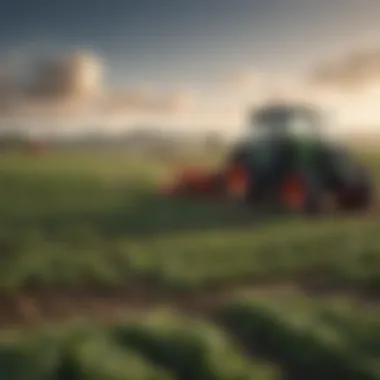Exploring Agricultural Materials: Innovations and Impact


Intro
Agricultural materials are fundamental in the realm of farming and food production. These materials can significantly affect crop yield, soil health, and overall sustainability within the agricultural sector. Understanding the variety of materials used in agriculture is essential for students, researchers, and professionals alike. This article endeavors to unpack the complexities surrounding agricultural materials, highlighting their classifications, applications, innovations, and impacts on modern farming practices.
The urgency for sustainable solutions in agriculture underscores the importance of discussing these materials. With the increasing pressures of climate change and population growth, there is a pivotal need for efficient resource management and material innovation in agriculture. This comprehensive overview will guide readers through the various types of agricultural materials, focusing on their roles in cultivation and pest control, along with their contribution towards sustainable agricultural practices.
As we delve deeper into the themes of this article, attention will be given to both traditional and contemporary materials that are changing the farming landscape. Special emphasis will also be on emerging trends, such as the development of biodegradable alternatives and technological advancements that seek to minimize environmental impact. The journey through this topic will provide a solid framework for understanding the strategic use of materials in agriculture, empowering readers to appreciate the connection between these materials and the ecological footprint of farming activities.
Prelude to Agricultural Materials
Agricultural materials are integral to modern farming practices, influencing both productivity and sustainability. The significance of these materials extends beyond mere functionality; their chosen forms impact yield, soil health, and the overall ecosystem. Addressing this topic provides insight not only into the essentials of agriculture but also into the broader implications of material selection for future food systems.
Definition and Importance
Agricultural materials encompass a wide range of substances used in farming to enhance productivity, protect crops, and improve soil conditions. These materials can be biological, chemical, or physical. Understanding their definitions is key to discerning their applications and benefits.
The importance of these materials lies in their ability to support various agricultural practices. By selecting appropriate agricultural materials, farmers can achieve higher yields, ensure healthier soil, and minimize environmental impact. The right materials contribute to effective pest management, nutrient delivery, and even water conservation.
"Choosing the right agricultural materials is essential for sustainable agriculture and long-term food security."
Historical Context
The evolution of agricultural materials is closely tied to the development of agriculture itself. From ancient civilizations that relied on natural substances to sustain their crops, to the introduction of synthetic fertilizers in the 20th century, there has been a significant transition. Early materials primarily included well-decomposed organic matter, which enriched the soil with nutrients. Over time, the obsession with maximizing crop yields led to the synthesis of chemical inputs. A deep understanding of historical use helps us appreciate how far agricultural practices have come.
In the current context, many farmers and researchers are revisiting historical methods that prioritized ecological balance, seeking ways to integrate ancient approaches with modern innovation. This blend is now vital in addressing challenges like climate change and soil degradation, showing that the past holds relevance in shaping future agricultural practices.
Classification of Agricultural Materials
Understanding the classification of agricultural materials is crucial for several reasons. It allows for the systematic study and application of these materials in various agricultural processes. By categorizing agricultural materials, stakeholders such as farmers, researchers, and policymakers can make informed choices that impact productivity, sustainability, and environmental health. This classification aids in identifying the best materials suited for specific tasks, optimizing their use, and minimizing waste.
Biological Materials
Biological materials encompass a variety of living or derived components used in agriculture. This category includes organic substances, such as livestock manure, plant residues, and compost, which play a critical role in enhancing soil fertility and structure. These materials are organic in nature and contribute to soil health through the addition of necessary nutrients and the improvement of microbial activity.
Another example of biological materials are cover crops. They are grown primarily to prevent soil erosion and improve soil organic matter. The incorporation of these materials leads to better resilience against pests and diseases, while also enhancing biodiversity. Their use is a fundamental element of sustainable agriculture practices because they maintain environmental balance.
Chemical Materials
Chemical materials in agriculture pertain to synthetic or naturally derived compounds used to enhance plant growth, control pests, and manage soil properties. These materials include fertilizers, pesticides, and herbicides. Fertilizers such as urea, ammonium sulfate, and potassium chloride supply essential nutrients directly essential for plant growth. The proper use of chemical fertilizers can significantly increase crop yield, but it must be managed carefully to avoid negative environmental impacts, such as water pollution and soil degradation.
Pesticides, particularly chemical ones, are often used to protect crops from insects and diseases. While effective, the application of these substances raises concerns regarding human health and environmental safety. Alternatives like integrated pest management can help mitigate some of these issues by encouraging the use of biopesticides, which are derived from natural materials.
Physical Materials
Physical materials refer to non-biological and non-chemical components used in agriculture. This includes seeds, containers, tools, and machinery. Quality seeds are vital for successful cultivation as they determine the potential crop yield. The choice of seed variety is influenced by factors such as climate, soil type, and intended use.
Tools and machinery fall under this category as well. Tractors, tillers, and irrigation systems are examples of physical materials that enhance productivity in agricultural practices. The advancements in technology have brought about smart farming tools, enabling precision agriculture, which optimizes resource use and reduces waste.
In summary, classifying agricultural materials into biological, chemical, and physical categories offers a structured approach. This organization allows for better understanding, management, and innovative applications in modern agriculture.
Uses of Agricultural Materials
The spectrum of agricultural materials plays a pivotal role in both the productivity and sustainability of farming practices. These materials are used to enhance soil quality, protect crops, and improve overall agricultural outputs. Understanding the specific uses of these materials is critical for effective farm management and environmental stewardship. The right applications can increase yield, promote soil health, and ensure sustainable resource use. This section delves into various uses, detailing their significance and implications for agriculture today.


Soil Enhancers
Organic Amendments
Organic amendments are derived from natural sources. They include materials like compost, manure, and green manure crops. The primary contribution of organic amendments is their ability to improve soil structure and fertility. A key characteristic is their slow-release nature, enriching soil over time. This is why it is a beneficial choice for sustainable farming practices. Organic amendments significantly increase soil organic matter, which enhances moisture retention and provides a habitat for beneficial microorganisms.
The unique feature of organic amendments is their holistic approach to soil health. They provide essential nutrients while fostering a thriving ecosystem. However, some disadvantages may arise. For instance, their nutrient content varies, sometimes requiring additional fertilizers to meet crop needs. Nevertheless, the long-term benefits of using organic amendments generally outweigh these drawbacks.
Inorganic Fertilizers
Inorganic fertilizers are synthetic products, offering concentrated nutrients directly available to plants. Their primary contribution is rapid nutrient delivery. This characteristic makes them a popular choice for increasing crop yields over short periods. Farmers often rely on inorganic fertilizers for their predictability and effectiveness in enhancing plant growth.
The unique feature of inorganic fertilizers lies in their formulation, which allows precise control over nutrient applications. However, potential drawbacks exist. Over-reliance can lead to soil degradation and water contamination from runoff. Balancing the use of inorganic fertilizers with organic alternatives is essential to promote long-term soil health.
Pesticides and Herbicides
Pesticides and herbicides are critical in crop management. They help protect plants from pests and invasive weeds that threaten yields. Understanding their application and impact is important for modern agriculture.
Chemical Pesticides
Chemical pesticides are synthetic compounds designed to control pest populations. Their main contribution is effective pest control, which significantly boosts crop yields. A key characteristic of chemical pesticides is their broad-spectrum activity, allowing control of multiple pests simultaneously. Their efficiency makes them a common choice among farmers facing severe pest pressures.
However, the unique feature of chemical pesticides is also a disadvantage. Their use can lead to resistance in pest populations and potential harm to beneficial insects. Additionally, there are concerns about their effects on human health and the environment. Careful management and integrated pest management (IPM) strategies are necessary to mitigate these risks.
Biopesticides
Biopesticides are derived from natural materials, including plants and microorganisms. Their contribution is promoting a more sustainable approach to pest management. A key characteristic of biopesticides is their specificity; they often target specific pests without harming non-target species. This makes them a popular choice in organic agriculture and among environmentally conscious farmers.
The unique feature of biopesticides is their potential to reduce chemical inputs in agriculture. They often have a lower environmental impact. However, biopesticides may have limitations in efficacy and residual activity compared to chemical counterparts, requiring careful consideration in application.
Seed Coatings and Treatments
Seed coatings and treatments involve applying materials to seeds to improve germination and plant health. This practice is crucial in ensuring that seeds establish successfully in various conditions. Seed treatments can enhance protection against diseases and pests, contributing to more robust crop yields. They can also improve seedling vigor and contribute to overall agricultural productivity.
While seed coatings can offer benefits, they must be chosen carefully. Some treatments can be cost-prohibitive, and not all seeds respond positively to coatings. As the industry advances, it will be interesting to see how innovations improve these practices, ensuring their relevance in future agricultural systems.
Understanding the uses of agricultural materials is essential for optimizing crop production and ensuring environmental safety. This balance is key to a sustainable agricultural future.
Innovations in Agricultural Materials
Innovations within agricultural materials are vital for enhancing productivity, sustainability, and environmental protection. This section explores novel materials and technologies that redefine modern agriculture. The integration of science and technology leads to improved farming methodologies and better yields, ultimately ensuring food security. Furthermore, these innovations can address pressing issues like climate change and resource depletion.
Biodegradable Materials
The use of biodegradable materials is gaining traction in agriculture due to their reduced environmental footprint. These materials decompose naturally, minimizing waste accumulation in ecosystems. Examples include biodegradable mulches, which improve soil health while preventing weed growth. They help in retaining moisture and reducing the need for chemical weed control.
Another example is bioplastics made from natural sources, such as corn starch. These can replace conventional plastics in agricultural applications, like seedling pots and packaging. Using biodegradable materials reduces dependency on synthetic items that persist in the environment for centuries. It enhances soil quality as they contribute organic matter upon decomposition.
Nanotechnology Applications
Nanotechnology holds significant promise in agriculture. By manipulating materials at the molecular level, it allows development of products that are more effective and sustainable. Nanoparticles can enhance the efficiency of fertilizers by ensuring they are released slowly. This targeted delivery reduces the risk of nutrient runoff into water bodies, protecting aquatic ecosystems.
Moreover, nanotechnology improves pesticide effectiveness by allowing smaller doses to achieve the desired result. This reduces the overall amount of chemicals released into the environment while still controlling pests effectively. The combination of precision and reduced chemical usage presents significant ecological benefits. However, the implications of nano-pesticide residues on human health and the environment require further research.


Smart Materials and IoT Integration
Smart materials, combined with Internet of Things (IoT) technology, are transforming agricultural practices by introducing real-time monitoring and automation. These materials can respond to environmental stimuli, providing data that can optimize irrigation, fertilization, or pest management.
For example, soil moisture sensors connected to a central system can precisely determine when to irrigate crops. This limits water use and enhances crop health. Additionally, smart materials can help in the creation of dynamic greenhouses that adjust to changing weather conditions automatically.
The integration of IoT with smart materials enables farmers to make informed decisions based on accurate data. This not only increases efficiency but also fosters a more sustainable agricultural approach.
Innovations in agricultural materials present a pathway towards greener practices and increased productivity, essential for addressing global food demands.
Environmental Impact of Agricultural Materials
The impact of agricultural materials on the environment is a critical area of study that outlines the interaction between farming practices and ecological health. Understanding how materials are used can lead to better sustainability practices. The use of fertilizers, pesticides, and various soil amendments bring both benefits and challenges. The balance between food production and environmental conservation is delicate. In this section, several specific elements are considered, including sustainability, soil health, and water conservation.
Sustainability Considerations
Sustainability in agriculture involves the methods and materials used to ensure that farming is ecologically sound. This includes the adoption of practices that do not deplete resources faster than they can be replenished. The emphasis is on renewable resources, which can mitigate negative environmental impacts.
- Organic farming emphasizes the use of natural materials, which can lead to healthier ecosystems.
- Integrated pest management blends biological control and minimal chemical use. This can lower biodiversity loss and prevent resistance in pests.
- Crop rotation supports soil fertility and in turn reduces the need for synthetic fertilizers.
This thoughtful approach aids in maintaining the long-term productivity of the land while minimizing the ecological footprint. Sustainable practices not only bolster agricultural resilience but also ensure that future generations can farm effectively.
Impact on Soil Health
Soil health is directly linked to the types of materials and practices employed in agriculture. Healthy soil is a living entity that supports plant growth and the overall ecosystem. The choice of agricultural materials affects its structure, fertility, and biological activity.
Several aspects are crucial here:
- Soil amendments, like compost and biochar, enhance soil organic matter, improving its structure and nutrient retention.
- Chemical fertilizers can lead to soil acidification over time, negatively affecting microbial communities.
- Pesticides can disrupt soil organisms, harming beneficial microbes that are essential for nutrient cycling.
A comprehensive understanding of these implications is vital for developing farming methods that preserve soil health while meeting production goals.
Water Usage and Conservation
Water conservation in agriculture is becoming increasingly important. Mismanagement of water resources can lead to severe consequences such as droughts, salinization, and depletion of water bodies. Different agricultural materials can enhance water efficiency.
To optimize water usage, consider the following strategies:
- Drip irrigation systems, which minimize waste by delivering water directly to the roots.
- Soil mulching can reduce evaporation, helping to keep soil moist.
- Rainwater harvesting systems allow farmers to capture and store water for later use.
Efficient water management practices are crucial in ensuring that agricultural practices do not compromise water quality or availability. The goal is to effectively produce food while conserving a precious resource that is essential for all life.
By focusing on sustainable practices and considering their broader environmental impact, agriculture can achieve productivity goals without compromising ecological integrity.
Case Studies on Agricultural Materials
Case studies play a vital role in the understanding of agricultural materials. They provide real-world examples that illustrate both the successes and failures of various agricultural approaches. By examining specific instances where agricultural materials have been implemented, readers can grasp the practical implications of theoretical concepts discussed earlier in the article. These case studies not only highlight innovative practices but also reflect the challenges faced by practitioners in an evolving agricultural landscape.
Understanding the impact of materials through case studies allows researchers, students, and professionals to make informed decisions. They can analyze what worked, what did not, and why. This depth of insight encourages the adoption of successful strategies while cautioning against approaches that may lead to negative outcomes.
Success Stories
Numerous success stories underline the positive impact of strategic agricultural materials. For example, the use of biodegradable mulching films in a tomato farm in Spain increased crop yield while minimizing environmental impact. Farmers found that these materials, made from corn starch, broke down over time, reducing waste and supporting soil health.


Another notable success story comes from a study in India that implemented organic fertilizers. Rice farmers who transitioned to compost and manure reported improved soil structure and fertility. Importantly, they also saw a reduction in chemical inputs, leading to better long-term sustainability.
These examples reflect the increasing trend towards environmentally-friendly agricultural practices. Furthermore, they offer valuable lessons for other regions and crops, potentially guiding future implementations of agricultural materials.
Challenges Faced
Despite the successes, agricultural professionals encounter numerous challenges. The unpredictability of climate and pest populations can undermine the benefits of new materials. For instance, in some regions, the introduction of organic pesticides faced resistance due to inconsistent results compared to conventional chemicals.
The cost of switching to sustainable materials also presents a hurdle. Farmers may struggle with the initial investment required for advanced technologies or organic solutions. This gap in financial resources can limit access to effective agricultural materials, especially in underdeveloped areas.
Additionally, the variability in soil types and local ecosystems complicates the generalizability of successful cases. What works in one place often does not easily translate to another. This underscores the need for localized research and adaptation of agricultural practices tailored to unique conditions.
"Innovations in agricultural materials require adaptation and ongoing research to meet local needs effectively."
In summary, while case studies reveal extraordinary advancements in agricultural materials, they also highlight significant obstacles that must be addressed. A balanced view enables a more nuanced understanding of the agricultural landscape, paving the way for future innovations.
Future Directions for Agricultural Materials
The realm of agricultural materials is on the cusp of significant transformations. As the global population continues to rise, the demand for efficient and sustainable farming practices becomes more pressing. Future developments in this sector are vital for ensuring food security while minimizing environmental impact. The integration of innovative materials and technologies offers a glimpse into how the agricultural landscape can change.
Research Trends
Research in agricultural materials is evolving rapidly, focusing on improving efficiency and sustainability. Key areas of interest include:
- Biodegradable materials: Research is underway to develop materials that can break down naturally, reducing the reliance on synthetic options that persist in the environment. These materials can be used in various applications, from packaging to soil amendments.
- Advancements in nanotechnology: Nanotechnology is showing promise in enhancing the effectiveness of pesticides and fertilizers. Smaller, targeted applications can lead to higher efficiency and lower environmental footprints.
- Genetically engineered materials: Research in biotechnology is driving the development of new materials that can enhance crop resilience. Such innovations can lead to better resource management, especially in regions vulnerable to climate change.
Ongoing studies in these areas will be critical not only for improving agricultural practices but also for addressing the challenges posed by climate change and resource scarcity.
Policy Implications
The future direction of agricultural materials is also closely linked to policy considerations. Policymakers play an integral role in shaping the framework within which agricultural materials are developed and used. Some pressing highlights include:
- Regulation of new materials: With the introduction of biodegradable and genetically engineered materials, regulatory frameworks must evolve to ensure safety and efficacy. This involves assessing the environmental risks associated with novel materials.
- Support for sustainable practices: Policymakers need to incentivize practices that prioritize sustainability. This can include funding research and development initiatives focused on eco-friendly materials and technologies.
- Collaboration between sectors: Encouraging partnerships between government, academia, and industry can drive innovation. Effective collaboration ensures that research translates into practical applications that benefit the agricultural sector.
Overall, the direction of research and policy in agricultural materials is essential for addressing future challenges. As these areas develop, they will determine how effectively society can utilize resources while safeguarding the environment for future generations.
"The progress in agricultural materials will require a symbiotic relationship between research and policy to create a sustainable agricultural future."
Future directions in agricultural materials hint at a promising evolution. With careful attention to research trends and policy implications, the agricultural sector can move toward a more sustainable and productive future.
Culmination
The conclusion serves as a vital element in rounding off the discussion on agricultural materials covered in this article. This section synthesizes the key points while also highlighting the broader implications of these materials in modern agriculture. Understanding the classification of agricultural materials, their various uses, and the innovations that continue to transform farming practices is essential for all stakeholders involved in agriculture.
Summary of Key Points
Throughout the article, several fundamental aspects about agricultural materials have been discussed, including:
- Definition and Importance: Agricultural materials play a critical role in enhancing productivity and sustainability in farming practices.
- Classification: These materials can be categorized into biological, chemical, and physical, each serving distinct functions crucial to agricultural success.
- Applications: Various uses, such as soil enhancers and biopesticides, highlight the multifaceted nature of these materials in improving crop yields and controlling pests.
- Innovations: Emerging trends like biodegradable materials and smart technologies represent future directions that can mitigate environmental impacts.
- Environmental Impact: Awareness of sustainability considerations and the consequences of material usage on soil and water resources is critical for responsible farming.
As we reflect on these points, it becomes clear that the integration of innovative agricultural materials not only enhances productivity but also fosters sustainable practices critical for future generations.
Call for Further Research
In light of the challenges and opportunities presented in the agricultural sector, further research is essential. Future studies should focus on:
- Exploring the Efficacy of Innovations: Continued assessment of biodegradable materials and nanotechnology applications can provide insights into their long-term benefits compared to traditional practices.
- Sustainability Metrics: Development of metrics to evaluate the sustainability impact of different agricultural materials will aid farmers and policymakers in making informed decisions.
- Cross-Disciplinary Approaches: Collaboration among scientists, researchers, and agricultural practitioners can lead to breakthroughs in understanding the interactions between various materials and their effects on ecosystems.
- Policy Development: Research examining the effects of policy initiatives on the adoption of sustainable materials in agriculture is vital for promoting environmentally friendly practices.
In summary, the call for further research is not merely a suggestion but a directive that emphasizes the importance of continual improvement and adaptation in agricultural practices.



